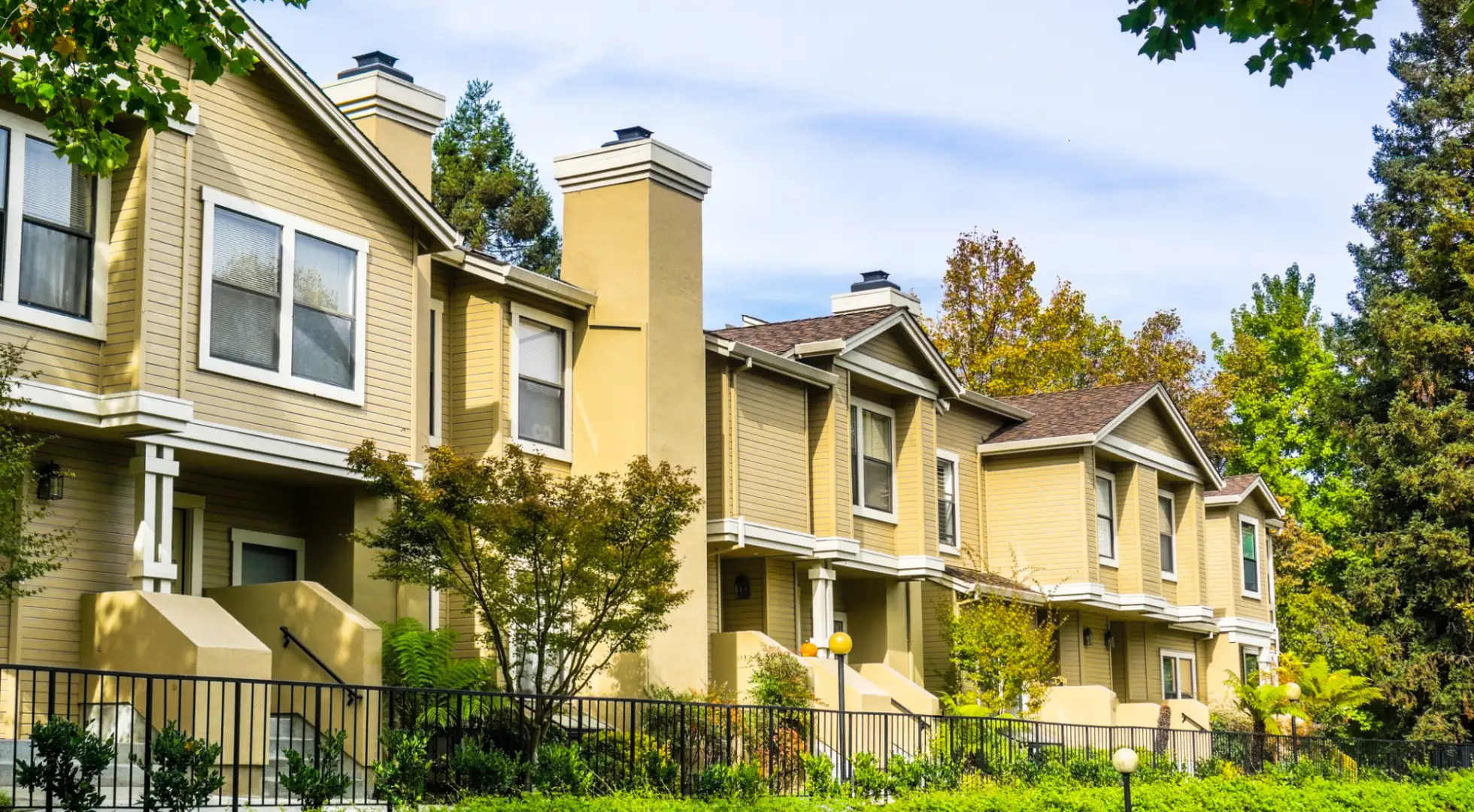How To Get Owner-Occupied Multifamily Financing In 2025

Lenders allow you to buy a multifamily property of 2-4 units, live in one unit, and rent out the rest. This can be a solid investment strategy, even for first-time buyers.
Most people love the idea of investing in real estate. There are so many upsides: property appreciation, rental income, generating long-term wealth, and the pride of running a small business.
However, fear holds a lot of people back from taking the plunge.
Here's how to safely invest in property using an owner-occupied mortgage loan.
What Is Owner-Occupied Multifamily Investing?
In short, owner-occupied multifamily investing is when you purchase and live in one unit of a multifamily (2-4 unit) home and rent out the others.
This strategy, known as “house hacking,” opens a massive door of opportunity for those who want to start investing but lack a large down payment or still need a place to live.
The FHA, VA, Fannie Mae, and Freddie Mac consider duplexes, triplexes, and fourplexes “residential properties.”
Because the property checks out as “owner-occupied” and “residential,” you can finance up to 96.5% of the purchase price, also known as 3.5% down, with an FHA multifamily loan. Military borrowers can qualify for a 0% down loan for a multiunit property, too. You can also get a conventional multifamily loan with just 5% down. (More on loan programs later.)
Multifamily home financing allows you to begin your real estate investing career with a low down payment and flexible borrowing options. Let’s find out how.
Advantages of Buying an Owner-Occupied Multifamily Home
Owner-occupied real estate investing is a good way to get started in real estate.
Here’s how you can benefit.
Gain financial independence: Generating rental income can make your home self-sufficient. Your mortgage payment stays the same, but rents are determined by market demand.
Live in the home for 12 months: If you don’t love the idea of living a wall away from your tenants, you only have to live in the property for 12 months to meet the owner-occupied rule. You can then purchase another multiunit property, rinse and repeat.
Future cash flow: As rents rise and your mortgage stays the same, your cash flow will grow, eventually paying your living expenses and offsetting your entire mortgage payment.
Invest now rather than later: If you buy a single-family home, it could be over a decade before you establish enough income and savings to qualify to buy a separate investment property. Jump in at year 1 with house hacking.
Access higher loan amounts: FHA, VA, and conventional loans allow larger loan amounts for 2-, 3-, and 4-unit properties. For example, in 2025, the FHA loan limit for a 4-unit home starts at over $1 million in many areas — and can exceed $2 million in high-cost markets like parts of California and Hawaii.
Get landlord experience early: Some loan programs require you to have two years of landlord experience before you count any rental income on a property you are vacating. Within two years, you can move out of the multifamily property and use its rental income to offset its payment, making it easier to qualify for the next home.
Owner-Occupied Multifamily Disadvantages
No worthwhile investment is without downsides. Here are some of the drawbacks of house hacking.
Learning curve: You’ll be learning to be both a homeowner and a landlord at the same time — two big responsibilities that come with their own challenges. Fortunately, there are plenty of free resources, communities, and guides available to help you get up to speed. Others have made plenty of mistakes — there’s no reason you need to repeat them.
Liability: Renting out part of your property comes with legal and financial risks. There's always the chance of lawsuits, property damage, or renters who don’t pay — which means you’re still on the hook for the full mortgage. Consider getting a strong umbrella insurance policy, hiring a lawyer to draft your lease agreements, and thoroughly vetting tenants with background and credit checks to minimize these risks.
Being a landlord: You may have to evict a tenant or have tough conversations about disruptive behavior or damage, and not everyone is up to those tasks. You could hire a property manager to deal with tenants, but you’ll need to account for the added cost.
While the pros far outweigh the cons, you should go into your venture fully aware of the ups and downs you’ll face as a landlord.
Best Owner-Occupied Multifamily Financing Options
Buying an owner-occupied multifamily property means getting better rates, lower down payments, and more favorable financing terms.
As mentioned, if you go to a lender today and ask for a “non-owner-occupied” loan or “rental property loan” they will make you pay 20-25% down and charge you a sky-high rate at least 1-2% higher than owner-occupied rates.
This is because non-owner-occupied loans are considered riskier. A landlord will stop making payments on a rental home before a primary home.
But buying an owner-occupied home, even with extra units you rent out, comes with some attractive borrowing perks.
Here are the best owner-occupied multifamily financing options.
1. FHA Loan
FHA multifamily loans require just 3.5% down. You can have a credit score as low as 580 and still qualify, though some lenders may require a higher score. You can use future rental income to qualify even if you have zero landlord experience. You can have a debt-to-income ratio of more than 50% in some cases, meaning your payment can be over half of your gross income, letting you qualify for more home than with a Fannie Mae or Freddie Mac conventional loan.
However, know that if you buy a triplex or fourplex, the property will need to pass FHA’s self-sufficiency test showing that the property’s potential rent can support the full payment.
Live in an expensive area? Surprisingly, you can get an FHA loan of more than $2 million for some multifamily properties in some high-cost areas of the country.
2. Fannie Mae Conventional
An owner-occupied conventional loan isn’t quite as flexible as FHA, but it can be the best program for those with high income, a bigger down payment, and great credit.
To buy a 2-4 unit home, you’ll need 5% down. Prior to this drastic reduction, Fannie Mae required 15% to 25% down.
3. Freddie Mac Conventional
Freddie Mac does not offer 5%-down multifamily financing unless you meet income limits for the Home Possible program. However, many borrowers won't qualify for a multifamily loan at this income. So far, Freddie Mac still requires 15% down for a 2-unit home and 20% down for a 3-4-unit home.
4. VA Loan
Borrowers with current or former military service have access to an incredible owner-occupied financing option: the VA home loan.
It requires zero down, even for 2-4 unit properties. It also offers below-market rates, no monthly mortgage insurance, and lenient credit score standards. While it’s hands-down the best multifamily loan on the market, you have to have at least 90 days of active duty or two years of former U.S. military service to be eligible.
How To Buy a Multifamily Property
Buying a multifamily home is similar to buying a single-family residence.
Make a budget: Make sure you have the income to support the payment and are comfortable taking on a large home payment. Ensure your budget allows for extra expenses like maintenance and periods of vacancy.
Get preapproved for a mortgage: A preapproval tells you what you can qualify for, making some assumptions about future home price, rental income, and other costs.
Hire the right real estate agent: Find an agent who is well-versed in multifamily homebuying or house hacking. A generalist may not be able to guide you to the best deals.
Shop for multifamily properties: Examine the local rental market and ask your agent how much the units will rent for and if there’s strong demand.
Make an offer on the right home: Expect fierce competition from all-cash investors and experienced buyers with large down payments. You'll likely need to make offers on several properties. If you can't find a turnkey home, use an FHA 203k rehab loan to buy and repair the multifamily home.
Get current lease agreements: Your agent can request these from the seller after your offer is accepted. The lender will order an appraisal and gather any final financial documents to underwrite and approve your loan.
Complete the transaction: You’ll pay the down payment and closing costs, and sign final paperwork at closing. Once the loan funds, the home is officially yours. Honor any existing rental agreements, although you should be able to displace one current tenant for owner-occupancy. Make sure the tenants know to make future rent payments to you.
Create new leases: After the current agreements expire, draft new leases with each tenant showing you as the landlord. Manage the property, be firm but fair with tenants, and you’ll have an additional long-term source of income.
Use Future Rental Income To Qualify
One of the biggest advantages of a multifamily purchase is that lenders allow you to count future rental income on the property to qualify for the loan.
For instance, you’re buying a duplex with a total payment of $3,000 per month. You get a market rent analysis (included with the appraisal) that says you can rent one side for $1,500 per month. You can count 75% of the market rent, or $1,125 per month. In this example, the lender adds $1,125 per month to your employment income to help you qualify.
In some cases, you can qualify for a multifamily when you can’t qualify for single-family home due to future rental income.
Getting Loan Assistance Buying a Multifamily Property
You can get down payment and closing cost assistance to help you buy a multifamily home.
Down payment assistance
You can get well over $10,000 to help with your down payment in many areas of the country. There are down payment assistance programs in every state. They are highly local, some applying to a certain city or county, and all have different rules. By researching programs in your area, you could get funds to apply directly to your down payment.
For example, if you buy a $400,000 duplex with an FHA loan, the minimum down payment would be $14,000. But if you received $10,000 in assistance, you would only pay $4,000 of the total from personal funds.
Two nearly nationwide programs are as follows:
FHA Fast 100: Lets you finance your 3.5% down payment. Duplexes are allowed, but not 3-4 units
DPA Advantage: Covers your entire FHA 3.5% down payment with a grant. Allowed on 2-4 unit properties
Closing cost assistance
Closing costs are an extra 2% to 5% of the loan amount. These costs include title search and insurance, lender fees, appraisal, escrow services, credit report fees, property taxes that you prepay, and other third-party loan costs. However, you can request closing cost assistance from the seller to reduce your upfront cash outlay.
Gift funds
You can accept gift funds from family and even friends in some cases. If your parents or another relative are willing to help you buy a home, they can give you 100% of the down payment funds. That’s essentially like getting a zero-down loan for your multifamily investment.
Alternatives To Owner-Occupied Multifamily Investing
If you’re not quite ready to make the leap into multifamily investing, there are smaller baby steps you can take.
Rent out a room: You can buy a single-family home that’s slightly too large for your needs and rent out a room. In fact, you could rent out the entire house and live in one room if you’d like. You may not count future rental income to qualify in this case.
ADU: You could also find a single-family home with an accessory dwelling unit (ADU). FHA allows you to use future rental income from an ADU to qualify for the loan.
Can You Buy a Multifamily Property if You Already Own a Single-Family Home?
You may have already purchased a single-family home, but are considering moving into a multifamily home.
While this is possible, there are some caveats.
First, you can’t have two owner-occupied homes. The lender will assume you’re buying an investment property. You would have to sell the current home or prove you will rent it out.
Second, to use FHA financing, you can’t already have “adequate housing.” So you could sell your current home or, if you plan to keep and rent it, you have to make a good argument on why your current home is inadequate.
For instance, you recently had a child and the duplex has three bedrooms in one unit, while your current single-family home has two bedrooms. Or, the property might be closer to work or family. The lender may accept any number of reasons for the move.
Reducing Your Investing Risk With an Owner-Occupied Loan
Residential property is the safest real estate in which to invest. “Residential” is defined as 1-4 units. Anything with 5+ units is considered commercial.
You can save a lot of time by eliminating any 5+ unit homes from your search. You can’t get low-down-payment, owner-occupied financing for these properties, and they don’t come with the same borrower protections.
For one, many commercial loans are recourse loans. Residential loans, for the most part, are non-recourse.
Recourse vs non-recourse loans
A “recourse loan” means the lender can come after your personal assets — retirement savings, cars, furniture, and other properties — if you default on the loan.
A “non-recourse loan” is one where the lender can take only the property, limiting your losses to the property itself. If you lose your job or face income loss due to medical issues, for instance, the lender only comes for the property and not all of your other assets to recoup their loss.
Non-recourse loans such as those backed by FHA, VA, Fannie Mae, and Freddie Mac are helpful first-time investor tools because they limit losses in worst-case scenarios.
Living in the structure you’re renting out
Another protection of owner-occupied multifamily investing is that you can keep an eye on the property. If the landlord is next door, the tenant is more likely to take care of the property and behave. And if they break the terms of their lease, you can initiate eviction proceedings.
Owner-Occupied Multifamily Financing FAQ
What is the minimum down payment for an owner-occupied multifamily property?
You can purchase a multifamily home that you plan to live in for 3.5% down with an FHA loan and 0% down with a VA loan. As of November 2023, you can get conventional financing with 5% down.
How long do you have to live in an owner-occupied multifamily home?
Most loan types require you to move in within 60 days and live in the property as your primary residence for at least 12 months. This applies to FHA, VA, and most conventional loans, although specifics can vary slightly by program. Leaving earlier without a valid reason could raise red flags or violate loan terms.
Can I buy an owner-occupied 4-plex?
Yes, you can buy a 4-unit home and live in one unit and rent out the rest. This is still considered an owner-occupied property.
Bottom Line
Buying an owner-occupied multifamily home is a strategic way to set yourself up as a new real estate investor. By living in one unit and renting out the rest, you’re generating passive income that may eventually help cover all of your monthly housing expenses.
Before you jump in, though, make sure you understand the loan requirements, risks, and responsibilities of becoming a landlord. If you’re game, the opportunities to build long-term wealth could be a game-changer.








